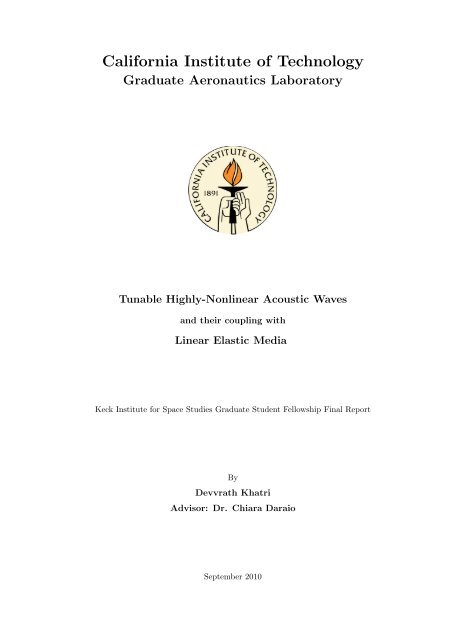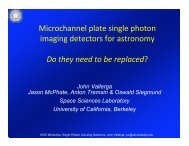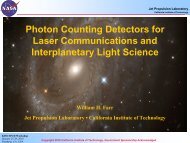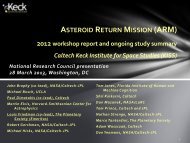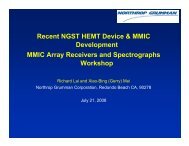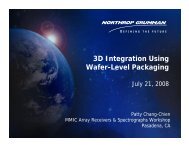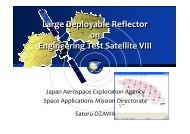Final Report - Keck Institute for Space Studies - Caltech
Final Report - Keck Institute for Space Studies - Caltech
Final Report - Keck Institute for Space Studies - Caltech
- No tags were found...
Create successful ePaper yourself
Turn your PDF publications into a flip-book with our unique Google optimized e-Paper software.
Cali<strong>for</strong>nia <strong>Institute</strong> of TechnologyGraduate Aeronautics LaboratoryTunable Highly-Nonlinear Acoustic Wavesand their coupling withLinear Elastic Media<strong>Keck</strong> <strong>Institute</strong> <strong>for</strong> <strong>Space</strong> <strong>Studies</strong> Graduate Student Fellowship <strong>Final</strong> <strong>Report</strong>ByDevvrath KhatriAdvisor: Dr. Chiara DaraioSeptember 2010
AcknowledgementI would like to convey my utmost gratitude to my advisor Dr.guidance and encouragement throughout the research.Chiara Daraio <strong>for</strong> her advice,Secondly I owe many thanks to Dr. Jinkyu Yang, Dr. Alessandro Spadoni, Dr. Duc Ngo, Dr. AbhaMisra <strong>for</strong> their useful advice and support in numerics and experiments to carry out the researchwork. I am also thankful to Petros Arakelian <strong>for</strong> his suggestions and help in building experimentalsetup. I wish to express my thanks to Chinthaka Mallikarachchi and Xiaowei Deng at <strong>Caltech</strong>,USA <strong>for</strong> suggestion on finite element simulations.Further, I would like to thank all of the Highly Nonlinear Group at Graduate Aeronautical Laboratories, <strong>Caltech</strong> <strong>for</strong> their constructive suggestions and helpful discussions.Last but not least I am grateful to my parents <strong>for</strong> their understanding and support.i
Acknowledgement to KISSW.M. <strong>Keck</strong> <strong>Institute</strong> <strong>for</strong> <strong>Space</strong> <strong>Studies</strong>,Graduate Student Fellowship,Cali<strong>for</strong>nia <strong>Institute</strong> of Technology,Pasadena, CA, 91125Members of <strong>Keck</strong> <strong>Institute</strong> <strong>for</strong> <strong>Space</strong> <strong>Studies</strong>,I will like to express my sincere gratitude to W.M. <strong>Keck</strong> <strong>Institute</strong> <strong>for</strong> <strong>Space</strong> <strong>Studies</strong> (KISS) <strong>for</strong> yourGraduate Student Fellowship. I am grateful to be considered as the recipient of your scholarship.I am a final year Ph.D. student in Aeronautics at Cali<strong>for</strong>nia <strong>Institute</strong> of Technology (<strong>Caltech</strong>)and plan to graduate in Spring of 2011. After graduation, I would like to pursue my career asa research scientist/engineer. The KISS Graduate Student Fellowship award has helped me incovering my financial expenses and allowed me to focus my time on research and learning. Thisfellowship enabled me to pay the expenses of using high per<strong>for</strong>mance computing cluster <strong>for</strong> myresearch purpose and also allowed me to attend the summer school in Italy on “Wave Propagationin Linear and Nonlinear Periodic Media: Analysis and Applications”.KISS Graduate Student Fellowship was crucial in allowing me to have the support and freedom toexplore the research topics that I am interested in. The financial support of the <strong>Keck</strong> <strong>Institute</strong> For<strong>Space</strong> <strong>Studies</strong> is greatly appreciated and it is their generosity that made this research possible.Thank You,Sincerely,Devvrath Khatriii
AbstractThis project aims at introducing and testing a new method of Non-Destructive Evaluation (NDE)and Structural Health Monitoring (SHM) <strong>for</strong> materials and engineering systems, based on theuse of Highly Nonlinear Acoustic Waves (HNAWs). At a fundamental level the project aims atunderstanding the interface behavior between linear and highly nonlinear media. The effects ofinterface dynamics on the temporary localization of incident waves and their decomposition intoreflected waves are investigated.We implemented a finite element model <strong>for</strong> HNAWs <strong>for</strong>mation and propagation in granular chainusing commercially available software Abaqus. We validated our finite element model with thetheoretical work of static loading between two beads using Hertz’s law and <strong>for</strong> dynamic impactloading <strong>for</strong> the <strong>for</strong>mation and propagation of solitary wave in the chain of beads using Nesterenko’stheory. We also compared our results with discrete particle model and corroborate the results withexperiments.To use nonlinear actuator system <strong>for</strong> NDE/SHM applications purpose, we studied the losses in theenergy transmission as wave propagate in chain of spherical beads. We proposed a quantitativelyaccurateextension of the Hertzian model encompassing realistic material dissipative effects in aone-dimensional chain of granular materials. Using an optimization scheme, we computed therelevant exponents and prefactors of the dissipative terms in the equations of motion. Using linearRayliegh damping we modeled the dissipation effects in the finite element simulations. We used theroot mean square deviation method to obtained the optimized mass proportional factor of damping.The experimental results are found to be in good agreement with proposed model in terms of waveamplitude and wave shape.To understand the coupling of nonlinear media with adjacent linear elastic media, we studiedexperimentally and numerically the effects of solitary waves interacting with different single- andmulti-layered media. We per<strong>for</strong>med the theoretical analysis of the coupling based on the longwavelengthapproximation in a one-dimensional chain of beads. The numerical predictions basedon discrete particle model and experimental results are in good agreement with the theoreticalanalysis. In our study, we found a correlation between the properties of reflected waves from theinterface and the elastic modulus of adjacent linear elastic media. For elastic modulus value belowthe critical limit, we monitored the generation of secondary reflected solitary waves at the interfaceand found the dependence of them on the ratio of elastic modulus of adjacent media and of thespherical particles.In order to understand the coupling of nonlinear actuator system with the composite media <strong>for</strong>NDE/SHM purpose, we further extended our study <strong>for</strong> the interaction of highly nonlinear acousticwaves with double layered media. The results shows a correlation between the properties of primaryreflected waves with the inertia of the top layer and the dependence of properties of secondaryreflected solitary waves on the bottom layer. The results were found in good agreement with theexperimental finding.The work done as part of this research enhances our understanding on the basic physics andtunability of nonlinear media, and further establishes a theoretical and numerical foundation in theapplications of NDE/SHM in various areas.iii
List of Figures1.1 Schematic diagram of nonlinear granular chain as an automated impact actuator inside a satellite.The reflected waves from the interface, buried defect/impurity and boundaries will be used tomonitor the structure. . . . . . . . . . . . . . . . . . . . . . . . . . . . . . . . . . . . . . 12.1 Schematic diagram of the experimental setup consisting of spherical bead particles in granular chain.Four steel rods are used as guided rail to support the beads in the chain. An identical bead is usedas striker to generate single pulse of wave. Schematic shows the sensor-particle connected withcomputer to collect the signal data of wave propagation. . . . . . . . . . . . . . . . . . . . . . 52.2 Quasi-Static Validation: (a) finite element model consisting of two spherical beads in Hertzian contact.The beads are given small displacement boundary condition and corresponding contact <strong>for</strong>ceis calculated from simulations. (b) the logarithmic fitting of the obtained contact <strong>for</strong>ce and applieddisplacement on the bead. The Y-axis and X-axis shows the contact <strong>for</strong>ce and δ in logarithmic scalerespectively. The dot values are numerically obtained contact <strong>for</strong>ce <strong>for</strong> the corresponding displacement,the solid line is the linear fit (c) Comparison of power law obtained from simulations (solidcurve) with the Hertz’s theory (Eq 2.1, dashed curve) . . . . . . . . . . . . . . . . . . . . . . 62.3 (a) Finite element model showing the one-dimensional chain of spherical beads in contact with eachother Force versus time plot <strong>for</strong> the solitary wave propagation in chain composing of 20 stainlesssteel beads (b) Experiments, (c) Discrete Hertz Law, (d) Abaqus simulation. The curves representthe wave propagation in particle number 10 (blue) and 15 (red) respectively from the top of thechain <strong>for</strong> striker velocity 0.626m/s.(e) Force-Velocity Scaling - The solid curve represents thetheoretical value using Eq 2.6, the square marker represents the discrete particle model values andthe dot marker represents the finite element value <strong>for</strong> Dependence of the solitary wave speed on themagnitude of the contact dynamic <strong>for</strong>ce. . . . . . . . . . . . . . . . . . . . . . . . . . . . . 73.1 a) Decay of solitary wave in chain of 70 stainless steel particles <strong>for</strong> striker velocity = 1.77m/s. Thesensor-particles are placed at 9, 16, 24, 31, 40, 50, 56, and 63 bead number and the solid curves(blue) corresponds to <strong>for</strong>ce value observe by them. The circle with solid curve (red), the trianglewith solid curve (magenta) and the square with dashed curve (red) represents the maximum valueof experimental, discrete particle and finite element model respectively. b) and c) . . . . . . . . . 94.1 Finite element model <strong>for</strong> coupling of 1D chain of nonlinear media composed of 20 spherical beadsparticle with adjacent linear elastic media (a) a uni<strong>for</strong>m linear medium and (b) a composite linearmedium. The bottom of the linear media is under fixed boundary conditions. . . . . . . . . . . 104.2 (a) Numerical results showing the surface plots of incident and reflected solitary waves in granularchain as a function of elastic modulus of the uni<strong>for</strong>m linear media adjacent to the chain of spheres.The Y-axis reports a set of different values of elastic moduli of the linear media adjacent to the chainof spheres. As the stiffness of the contact is decreased, the TOF of the reflected wave increases. (b)Amplitude Reflection ratio of the amplitude of the PSW over that of the incident solitary wave. (c)Amplitude Reflection ratio of the amplitude of the SSW over the amplitude of the incident solitarywave. The reflection ratio becomes smaller as the elastic modulus increases. . . . . . . . . . . . 114.3 (a) Numerical results showing the surface plots of incident and reflected solitary waves in granularchain as a function of height of the uni<strong>for</strong>m linear media adjacent to the chain of spheres. TheY-axis reports a set of different values of height of the linear media adjacent to the chain of spheres.The first band visible on the left represents the incoming solitary waves, while the band on the rightshows the reflected solitary waves (PSWs). No secondary solitary wave is observed. (b) AmplitudeReflection ratio of the amplitude of the PSW over that of the incident solitary wave. Numericalresults show a minute drop around the characteristic length of the linear medium. . . . . . . . . 11v
4.4 Comparison of experimental, theoretical, and numerical results <strong>for</strong> the time of arrival time on theinstrumented particle (TOF) and amplitude ratio of the primary and secondary reflected solitarywaves in the chain of spheres, as a function of the upper layer thickness (Lu) in the compositemedia. (a) TOF <strong>for</strong> the PSWs. The arrival time is within 0.43- to 0.47-ms range. (b) Amplituderatio <strong>for</strong> the PSWs. The amplitude reflection ratio increases as Lu grows. (c) Time of flight <strong>for</strong>the SSWs. Compared to that of the PSWs, the progression is in opposite direction with improvedresponsiveness. (d) Amplitude ratio of the SSWs. On the contrary to the PSW reflection in (b),larger Lu yields the smaller SSW reflection in compensation <strong>for</strong> the increased PSW reflection. Forthe upper layer taller than 22 mm, the magnitude of the reflection ratio drops below 10 . . . . . . 124.5 (a) Numerical results showing the surface plots of incident and reflected solitary waves in granularchain as a function of lower layer dimension of the composite linear media. The <strong>for</strong>mation of theprimary reflected solitary wave is insensitive to the lower layer thickness, showing the constantamplitude and arrival time <strong>for</strong> all lower layer thicknesses tested. However, the secondary solitarywaves reveal significant delay in their <strong>for</strong>mation as the dimension of the lower layer increases. (b)Amplitude reflection ratios of the PSWs. (c) Time of flight of the SSWs. as a function of lowermedium height (L d ). . . . . . . . . . . . . . . . . . . . . . . . . . . . . . . . . . . . . . 13vi
Chapter 1Introduction1.1 Introduction to Granular MediaAcoustic waves are commonly used <strong>for</strong> monitoring engineering systems <strong>for</strong> identifying structuralgeometry, flaw and acoustic behavior of structures. In the last few decades several stress wavebased inspection/monitoring techniques have been developed <strong>for</strong> damage detection and materialcharacterization in metallic and composite structures [Shull, 2002]. Such detailed in<strong>for</strong>mation onthe nature of the damage comes at the cost of extended time of interrogation, heavy data processingand require significant external power supply. Thus, there is a widespread need <strong>for</strong> new NDE/SHMtechniques, which can provide alternative solutions to long standing problems of actuation andsignal generation, improve accuracy and detection resolution and provide novel solution <strong>for</strong> signalprocessing.For this research we use granular systems to generate highly nonlinear acoustic waves as novelin<strong>for</strong>mation carriers to interrogate structures, as an alternative to classical instrumented hammersused in impact testing (Fig 1.1). By granular material, we refer to the aggregate of discretemacroscopic particles. The size of the granular particle is on a comparable scale to size of totalsystem and usually large enough such that they are not subject to thermal motion fluctuations.This granular materials interact with each other through dual nonlinearity, where in compressionthey follow a complete nonlinear behavior without any linear component and on the other side theyhave zero tensile <strong>for</strong>ce.When this granular material are assembled in a linear or network shaped arrangement, the dualnonlinearity of the system and the heterogeneity of the scales places them in a special class of highlynonlinear behavior. In the highly nonlinear regime, the traditional linear and weakly nonlinearcontinuum approach based on Korteveg - de Vries equation invalid.In 1984, Neseterenko [Nesterenko, 1983] discovered the <strong>for</strong>mation and propagation of highly nonlinearsolitary waves in chain of granular material. Since than, they have received a considerableattention over the last few years. Their unique character of asymmetric potential, tunability andnonlinearity has in turn led to the observation of several new phenomena of wave <strong>for</strong>mation andpropagation such as introduction of the concept of “sonic vacuum” due to the zero sound speed inuncompressed material.The use of solitary waves <strong>for</strong> the detection of defects and impurities in granular media was discussedFigure 1.1: Schematic diagram of nonlinear granular chain as an automated impact actuator inside a satellite.The reflected waves from the interface, buried defect/impurity and boundaries will be used to monitor the structure.1
y Sen, et al. [Sen et al., 1998] and by Hong, et.al. [Hong and Xu, 2002]. Solitary waves have beendemonstrated to be sensitive to the granular materials properties [Coste et al., 1997], such as theelastic modulus, as well as to the applied static preload [Daraio et al., 2006b, Coste et al., 1997]. Inaddition, the dependence of the backscattered signal’s velocity and shape on the presence of lightand heavy impurities in a granular chain has also been noted [Hong and Xu, 2002]. C. Daraio, et al[Daraio et al., 2006a] and L. Vergara [Vergara, 2006] showed the potential usefulness of this systemin energy trapping and shock disintegration work. Beside this some of the other area of applicationin which highly nonlinear waves can be useful are sound focusing devices (tunable acoustic lensesand delay lines), sound absorption layers, and sound scramblers [Daraio et al., 2005, Nesterenkoet al., 2005, Herbold et al., 2006, Spadoni and Daraio, 2010].1.2 Scope and AimThe goal of the project is to use the tunability and reliability of nonlinear actuator systems andto understand the coupling of nonlinear media with the adjacent linear elastic media with simplegeometry and to understand the losses incorporate in the one-dimensional chain of beads, as theHNAWs travels through them.The scope of the proposed research can be extended to the NDE/SHM to complicate engineeringstructures like space structures (satellites), aerospace structures (plate, stiffeners, wings, joints etcof aircrafts), ocean structures (oil rigs) and civil structures (bridges).1.3 Outline of the <strong>Report</strong>The subsequent sections in this report are arranged as follows:Chapter 2 reviews the background of the solitary waves in chain of granular particles. We describeour experimental setup and the conventional discrete particle model. Then it explains the finiteelement model developed in this project <strong>for</strong> <strong>for</strong>mation and propagation of HNAWs in chain ofbeads.Chapter 3 describes the dissipation losses in the nonlinear waves as they propagate in physicalnonlinear actuator composed of spherical beads in one-dimensional chain.Chapter 4 introduces the coupling of nonlinear media with adjacent linear elastic media.Chapter 5 ends the report by discussing the main conclusions and future work possible to betterunderstand the nonlinear actuator <strong>for</strong> NDE/SHM.2
Chapter 2Highly-Nonlinear acoustic waves in one-dimensional chainof spherical particles2.1 Theoretical BackgroundHighly nonlinear acoustic waves (HNAWs) were first reported numerically, experimentally and analyticallyin one-dimensional granular crystals (i.e. chains of spherical particles) [Nesterenko, 2001,1983]. Highly nonlinear media support acoustic pulses that have intrinsically different propertiesthan those found in conventional linear acoustic signals, allowing <strong>for</strong> a stronger degree of tunability[Daraio et al., 2006b] .Initially strongly pre-compressed, strongly nonlinear granular chains may behave as weakly nonlinearsystems similar to the one considered in the Fermi-Pasta-Ulam paper [Fermi et al., 1965] .When no static pre-compression is imposed on the granules, the resulting wave equation presentsno linear part: this had led to the introduction of the concept of “sonic vacuum” (SV) - a mediumwhere no characteristic sound speed is present (c 0 = 0) and the traditional wave equation is nolonger the basic equation <strong>for</strong> representing the wave dynamics.The general contact relation between two linear elastic particles undergoing point contact can beexpressed by the nonlinear Hertzian contact law [Johnson, 1987] :F = kδ n (2.1)where, (F ) is the compressive <strong>for</strong>ce between particle on contact with each other; k is functionof the particle’s material and dimension parameter (radius of contact, Poisson ratio and elasticmodulus), <strong>for</strong> two identical spherical bead in contact, k ≡ k s = E√ 2R;n is the nonlinear exponent3(1−ν 2 )(with n > 1); and δ is the displacement of distant point of each body. The <strong>for</strong>ce (F ) is consideredpositive in compression (δ > 0) and zero in tension (δ < 0) (particles can freely move apart fromeach other). The stiffness constant value k and power-law relationship n are two of the importantfactor in tunning the nonlinear waves, which we will explain in the following sections.To describe the <strong>for</strong>mation and propagation of the highly nonlinear solitary waves in the granularchain, Nesterenko considered particles in the chain interacting with neighboring particle accordingto the Hertz’s Law Eq 2.1 . From this discrete system, a continuum approach based on longwavelength approximation was derived <strong>for</strong> uni<strong>for</strong>m chain [Nesterenko, 1983, 2001] . The waveequation thus obtained <strong>for</strong> the highly nonlinear system is:{u tt = −c 2 (−u x ) 3/2 + a2 [ ( (−u x ) 1/4 (−u x ) 5/4) ] }10xxx(2.2)where u is the displacement, a the particle’s diameter, c a material’s constant, and the subscriptsindicate the derivative and −u x > 0. The constant c in Eq 2.2 is given by:c 2 =2Eπρ 0 (1 − ν 2 )(2.3)where E is the Young’s modulus, ρ 0 the density, and ν the Poisson coefficient. For the case ofuni<strong>for</strong>m chain of granular particle, with particle interacting according to Hertzian and no or very3
weak pre-compression acting on it, the exact solution <strong>for</strong> Eq 2.2 can be found as:( ) 5V2 2(√ )ξ = s104c 2 cos 4 5a (x − V st)(2.4)where ξ represents the strain and V s the solitary wave velocity.The solitary wave are the stress pulses that can <strong>for</strong>m and travel in highly nonlinear system (i.e.granular, layered, fibrous or porous materials) with a finite spatial dimension that is independenton the wave amplitude. By a small variation of the particles assembling, <strong>for</strong> example, it is possibleto significantly alter the properties (wave length, speed, amplitude, and frequency) of the excitedpulse and the number of pulses in a given train [Daraio et al., 2006b]. The analytical expression<strong>for</strong> the tunability of the solitary waves speed V s derived from the discretization of the particles inthe chain can be described as follows [Daraio et al., 2006b]:(4E 2 ) 1/6 {F 01 4V s = 0.9314a 2 ρ 3 (1 − ν 2 ) 2 (fr 2/3 − 1) 15[] } 1/23 + 2fr 5/3 − 5fr2/3(2.5)where F 0 represents the static pre-stress (pre-compression) added to the system, f r = F d /F 0 andF d is the maximum contacts <strong>for</strong>ce between the particles in the discrete chain. For the case, whenthe system is no-pre-compressed, the Eq. 2.5 simplifies to(V s = 0.68022Eaρ 3/2 (1 − ν 2 )) 1/3F 1/6d(2.6)In the Eq. 2.6, we see that the velocity of solitary wave V s , is a nonlinear function of maximumdynamic <strong>for</strong>ce F d , which is different than the conventional linear waves, where the wave velocityonly depends on material property of the system. A plot showing the solitary wave velocity-<strong>for</strong>cescaling is shown in Fig 2.3e.Another interesting feature of the highly nonlinear solitary waves is determined by the fact that thesystem is size independent and the solitary waves can there<strong>for</strong>e be in principle scalable to smalleror larger dimensions, according to the needs of each specific application.2.2 Experimental SetupIn our study, we analysis the a single solitary wave in the homogeneous chain of N granular particlescomposed of stainless steel beads (in this study N = 20, unless otherwise specified). Each bead hasdensity (ρ) = 8000kg/m 3 ; modulus of elasticity (E) = 193GP a; Poisson’s ratio (ν) = 0.3 [Carreteroet al., 2009]. The beads in the experiments are supported by guided rails consisting of four rods.The rails constraint the motion of bead in one-directional.The wave propagation within the granular chain is recorded by instrumented particles with piezosensorsembedded in them. The piezo-sensors particles are custom fabricated in our laboratory,by introducing the piezoelectric (lead zirconate titanate) sheet (RC ∼ 10 3 µs, Piezo Systems Inc.)with custom micro-miniature wiring (supplied by Piezo Systems Inc.) between two cut halves ofspherical bead (carved to accommodate wires (Fig. similar to Ref [Daraio et al., 2005])) and joiningthem using epoxy adhesives. The two halves of bead were fabricated such that the total mass ofsensor-bead is equal to the mass of the regular beads in the chain. All sensors were connectedto respective ports in Tektronix oscilloscope to monitor the <strong>for</strong>ce-time responses. The fabricatedsensor-particles are placed at selected locations in chain to obtain the electrical signal generatedduring the dynamic <strong>for</strong>ce wave propagation in the chain. All the sensor-particles were pre-calibrated4
using the momentum conservation principle. The calibration factor is used to convert the acquireddata in voltage from oscilloscope to the corresponding <strong>for</strong>ce measured by the sensor-particle duringthe wave propagation [Daraio et al., 2005]Single solitary wave is generated by impacting the chainwith an identical bead as in the chain [Nesterenko,2001]. The average wave velocity (V s ) is measured bycalculating the ratio of distance between the centers oftwo sensor-particle over transit time the wave takes betweenthe two sensor-particle. The average maximum<strong>for</strong>ce (F m ) between the two sensor-particle is calculatedby taking the average of the <strong>for</strong>ce amplitude at the twosensor-particle.2.3 Simulation2.3.1 Discrete Particle ModelThe conventional discrete particle model (DPM) <strong>for</strong> analyzingHNAWs propagation in granular chain is primarilybased on the impulse-momentum law. The discretemodel assumes each bead as a single point massconnected by a nonlinear spring with neighboring particle,thus imposing single degree of freedom. The nonlinearspring works according to Hertz law (Eq. 2.1) inFigure 2.1: Schematic diagram of the experimentalsetup consisting of spherical bead particlesin granular chain. Four steel rods are usedas guided rail to support the beads in the chain.An identical bead is used as striker to generatesingle pulse of wave. Schematic shows the sensorparticleconnected with computer to collect thesignal data of wave propagation.compression and in tension it applies zero <strong>for</strong>ce. Tocompare the results obtained from DPM with experimentalresults, we use the nearest neighboring averagemethod, where the <strong>for</strong>ce at the center of the bead iscalculated by averaging the contact <strong>for</strong>ce on either sideof the bead. This model has been used extensively tostudy the various properties of nonlinear waves in granularstructures and was very helpful in understanding the physics of nonlinear wave propagationand interaction [Sen et al., 1998, Nesterenko et al., 2005, Vergara, 2006, Daraio et al., 2006b, Doneyand Sen, 2006, Porter et al., 2008, 2009, Carretero et al., 2009] .2.3.2 Finite Element ModelThe DPM assumes each bead as a single point mass connected by a nonlinear spring with neighboringbeads. In this configuration, the bead receive an instantaneous change of motion upon impact.For a real bead, the stress generated at the contact point on one side, propagates into the interiorof the bead with a finite velocity (c 0 = √ E/ρ) and reaches at the contact point on the other side.This phenomena of wave propagation inside the bead transfers the momentum to the next bead.During this process, the stress waves inside the bead reflects at the bounding surfaces and producesoscillations and vibrations in the bead. In order to capture the local transient de<strong>for</strong>mations andstress propagation, we need modeling technique which is capable of discretizing the bead as threedimensional body instead of limiting to the single point mass assumption.We use commercially available software Abaqus [Simulia, 2008] <strong>for</strong> modeling the granular particlesas three dimensional finite element de<strong>for</strong>mable bodies. Abaqus allows highly non-linear transientdynamic analysis of phenomena like impacts and multi body interaction. It also offers the possibilityto manage several interactive entities simultaneously (impact of striker on bead, interaction between5
Figure 2.2: Quasi-Static Validation: (a) finite element model consisting of two spherical beads in Hertzian contact.The beads are given small displacement boundary condition and corresponding contact <strong>for</strong>ce is calculated fromsimulations. (b) the logarithmic fitting of the obtained contact <strong>for</strong>ce and applied displacement on the bead. TheY-axis and X-axis shows the contact <strong>for</strong>ce and δ in logarithmic scale respectively. The dot values are numericallyobtained contact <strong>for</strong>ce <strong>for</strong> the corresponding displacement, the solid line is the linear fit (c) Comparison of power lawobtained from simulations (solid curve) with the Hertz’s theory (Eq 2.1, dashed curve)beads). The analysis can introduce the dynamic in a way similar to that of the experiments,managing only the impact characteristic.In our finite element model (FEM), we use Abaqus/CAE to generate the model of the system andsolve the system of equation using central-difference operator in Abaqus/Explicit. The granularbeads were modeled as solid (continuum) three-dimensional elements and discretized the volumewith tetrahedral elements of second order (using modified 10-node tetrahedral (C3D10M)). Theseelements provide a robust solution during large de<strong>for</strong>mation and contact analyses and exhibit minimalvolumetric and shear locking during analysis. Beads were assumed to be made of homogeneouselastic material and were modeled by using the parameters <strong>for</strong> density, Young’s modulus, Poisson’sratio as presented in experimental section. For simplicity when analyzing only incoming solitarywaves, we modeled the base wall as a flat rigid body composed of R3D3 type of elements.During the wave propagation process in the chain composed of granular particles, the contactbetween two bodies become a crucial factor <strong>for</strong> producing a stable model. The system undergoessimultaneous multiple point contact between each neighboring particle. For this purpose, thecontact interaction between two bodies was defined using the contact pair technique with surfaceto-surfaceinteraction (Explicit) in Abaqus. In this pair one of the surfaces was selected as masterand the other as slave. Small-sliding kinematic constraints were applied on the contacts and zerofriction in the tangential direction and contact pressure-over closure in the normal direction wereused as the contact properties. The properties were selected such as to make the two bodiesundergoing contact would not overlap with each other.To validate the finite element contact model we compared it with Hertzian contact law. For this purposewe created two three-dimensional semi-spheres (Fig. 2.2a) finite element model and obtainedthe contact <strong>for</strong>ce (F) - displacement (δ) relation between two beads using quasi-static assumptions.In these simulations the lower bead was held firm by applying fixed boundary conditions and theupper bead was given a displacement boundary condition. We repeated this procedure <strong>for</strong> severalvalues of δ i (i = 1, 2, ..., N) to generate the F − δ plot, in order to make comparison with HertzTheory. The δ i values were selected such the they are insignificant compare to sphere’s radius, sothat small displacement assumptions of Hertz TheoryJohnson [1987]) are maintained. From thepower law fitting in logarithmic scales of the contact <strong>for</strong>ce-displacement response obtained fromthe model, we get the exponent equal to n = 1.5047 (Fig. 2.2b). Fig. 2.2c shows a good agreementbetween the F − δ curve calculated from the finite element model using the power law obtainedabove with Hertz’s theory (Eq 2.1).Similarly, we per<strong>for</strong>m the dynamic validation of FEM with experiments and DPM. An Abaqusmodel of the nonlinear granular system is shown in Fig 2.3a . Force-time plots corresponding tothe waves propagation in the chain of beads are obtained <strong>for</strong> discrete particle model, finite element6
Figure 2.3: (a) Finite element model showing the one-dimensional chain of spherical beads in contact with eachother Force versus time plot <strong>for</strong> the solitary wave propagation in chain composing of 20 stainless steel beads (b)Experiments, (c) Discrete Hertz Law, (d) Abaqus simulation. The curves represent the wave propagation in particlenumber 10 (blue) and 15 (red) respectively from the top of the chain <strong>for</strong> striker velocity 0.626m/s. (e) Force-VelocityScaling - The solid curve represents the theoretical value using Eq 2.6, the square marker represents the discreteparticle model values and the dot marker represents the finite element value <strong>for</strong> Dependence of the solitary wavespeed on the magnitude of the contact dynamic <strong>for</strong>ce.model and in experiments assuming same initial boundary conditions and striker velocity 0.626m/s.The <strong>for</strong>ce was measured <strong>for</strong> the 10 th and 15 th bead particle from the top of the chain. A comparisonof the wave speed in the three different cases shows a quantitative agreement: 641m/s, 635m/sand 610m/s <strong>for</strong> finite element, discrete model and experiments respectively. The results obtainedfrom finite element simulation (shown in Fig 2.3d) are in good agreement in terms of qualitativepulse shape, amplitudes and lengths with <strong>for</strong>ce profile calculated from discrete model (shown inFig 2.3c) and experiments Fig 2.3b.The relation between the solitary wave velocity V s and maximum contact <strong>for</strong>ce F d as described inEq 2.6 <strong>for</strong> the long wave length approximation obtained from finite element is shown in Fig 2.3ealong with the conventional discrete particle model and theoretical values, calculated in a similarmanner as described in Ref 6. We see that the wave velocity in the finite element model goes tozero as the dynamic <strong>for</strong>ce decreases and agrees well with discrete particle and theoretical values.Thus the finite element model is able to describe the HNAWs in chain of beads in terms of shape,length, amplitude and velocity.7
Chapter 3Dissipation in one-dimensional chain of spherical particlesDissipation plays an important role in waves propagation <strong>for</strong> physical system. The basic nondissipativeHertzian <strong>for</strong>ce model is good to predict the solitary wave properties, qualitatively andquantitatively has been used extensively in most of these dynamical studies, recent experimentalinvestigations have shown a qualitative change in <strong>for</strong>ce amplitude as the solitary wave propagatesin the chain of spherical beadsCarretero et al. [2009], Herbold et al. [2006]. These losses can be dueto inherent material propertiesJob et al. [2005], friction between the supporting guide and beads,contact nature between neighboring particles, vibrational effects or due to uncontrolled featuresin the experimental setup. We developed an analytical model <strong>for</strong> DPM and also included thedissipation effects in FEM and verified them with experiments.3.1 Experimental setupWe assembled a uni<strong>for</strong>m monodisperse chain of N = 70 particles of different materials (see Table I)with radius R = 2.38mm in a horizontal setup (as explained in section 2.2). We generated solitarywaves by impacting the chain with an identical striker to the particles in the chain. The impactvelocities were v imp = [1.77, 1.55, 1.40, 1.04, 0.79](m/s).3.2 Simulation3.2.1 Discrete Empirical ModelWe model a chain of N spherical beads as a 1D lattice with Hertzian interactions [Nesterenko,2001]:( )ÿ n = A δn 3/2 − δ 3/2n+1+ γ ∣ ˙δ n − ˙δ∣ ∣∣αn+1 , (3.1)where s ≡ sgn( ˙δ n − ˙δ n+1 ), A ≡ E √ 2R/[3m ( 1 − ν 2) ], n ∈ {1, . . . , N}, y n is the coordinate of thecenter of the n-th bead, δ n ≡ max{y n−1 − y n , 0} <strong>for</strong> n ∈ {2, . . . , N}, δ 1 ≡ 0, δ N+1 ≡ max{y N , 0},E is the Young’s (elastic) modulus of the beads, ν is their Poisson ratio, m is their mass, and R istheir radius. The particle n = 0 represents the striker.The γ < 0 is the friction coefficient and α is the power law <strong>for</strong> the dissipation. Both α and γ were determinedby optimizing the numerical results with experimental findings. Table 3.1 summarize ourresults, <strong>for</strong> three different set of experiments—using steel, teflon (polytetrafluoroethylene; PTFE),Material m (g) E (GPa) ν α γSteel 0.45 193 0.30 1.81 ± 0.25 −5.58 ± 1.30PTFE 0.123 1.46 0.46 1.78 ± 0.14 −0.582 ± 0.087Brass 0.48 103 0.34 1.85 ± 0.13 −6.84 ± 0.66Table 3.1: Material properties (mass m, elastic modulus E, and Poisson ratio ν) <strong>for</strong> stainless steel,PTFE, and brass. The last two columns present our best estimates, together with their standarddeviation, of the dissipation coefficients (α, γ).8
Figure 3.1: a) Decay of solitary wave in chain of 70 stainless steel particles <strong>for</strong> striker velocity = 1.77m/s. Thesensor-particles are placed at 9, 16, 24, 31, 40, 50, 56, and 63 bead number and the solid curves (blue) correspondsto <strong>for</strong>ce value observe by them. The circle with solid curve (red), the triangle with solid curve (magenta) and thesquare with dashed curve (red) represents the maximum value of experimental, discrete particle and finite elementmodel respectively. b) and c)and brass beads—in the last two columns. We found that the dissipation prefactor is materialdependentand a common exponent. This allowed us to augment the standard DPM based onHertzian <strong>for</strong>ces to encompass this dissipation effect in (optimal) quantitative agreement with ourexperiments.3.2.2 Finite Element ModelThe governing equation of motion <strong>for</strong> nonlinear dynamic response of finite element system in Abaqusis given by:[M] t Ü + [C] t ˙U + [K] t U t = R t ext (3.2)The energy loss <strong>for</strong> a dissipative physical system (Eq. 3.2) is controlled by the damping matrix [C] t .The damping matrix is modeled according to Rayleigh method, were it is assumed to be a linearcombination of mass and stiffness matrices [Hughes and Cliffs, 1987] .C = C M + C K = α 1 M + α 2 K (3.3)where α 1 and α 2 are real scalers. Rayleigh parameter helps in damping lower (mass proportional)and higher (stiffness proportional) frequency signal. In our current study, because the diameter ofthe beads are in macroscopic range hence, the frequency of waves is on the lower side of spectrum.There<strong>for</strong>e, the dominating factor <strong>for</strong> damping of waves in our finite element model is α 1 (massproportional damping). The value of α 1 is determined by optimization process, which involvesminimizing the residual differences (RMSD(α 1 )) between numerical and experimental data.3.3 ResultsFig. 3.1a shows the wave propagation obtained from the 8 sensor-particles placed in the chain,DPM Carretero et al. [2009] and FEM with dissipation included <strong>for</strong> the α 1 value calculated above.To better understand the effect of numerical dissipation on wave pulse, we compared the shape pulsewith <strong>for</strong>ce profile of two sensor-particle in the experiment (one sensor-particle at the front zone andsecond at the rear zone of the chain respectively). Fig 3.1b and Fig 3.1c shows the <strong>for</strong>ce profile ofexperiment result <strong>for</strong> bead particle number 16 and 56 respectively, from top in solid curve (blue).The dashed curve (red) is <strong>for</strong> the discrete particle model and the dot-dashed curve (magenta) is<strong>for</strong> the finite element model with α 1 . We see a small local difference in the wave amplitude offinite element model <strong>for</strong> both the sensor-particle, which is evident from Fig. 3.1a, this is becausethe Rayleigh wave damping used in finite element model is a linear mass proportional damping.Nevertheless, the DPM and FEM is capable to captures the trend of wave amplitude decay <strong>for</strong>the over all chain (Fig 3.1a), wave pulse and velocity in<strong>for</strong>mation within small error margin andaccurately.9
Chapter 4Coupling of Nonlinear Media with Linear MediaOne of the new applications of nonlinear acoustic wave proposed by our group is use of HNAWs <strong>for</strong>Non-Destructive Evaluation/Structural Health Monitoring (NDE/SHM) of structure [Eggenspieleret al., 2008, Daraio and Rizzo, 2008, Khatri et al., 2008, 2009]. In order to use the granularsystem as pulse excitation <strong>for</strong> NDE/SHM, we need to understand the wave reflection, scatteringand localization at the interface of granular media and the linear media (specimen). Reflection andlocalization of solitary wave with rigid wall and elastic wall of various hardness has been persuadedin the past, but a complete understanding of nonlinear and linear elastic media is still lacking. Inorder to understand the interaction of granular media with adjacent linear media, we per<strong>for</strong>med adetail study, theoretically and numerically (discrete and finite element model), of wave reflectionand scattering at the interface and verify them with experiments [Yang et al., 2010] .The experimental setup consists of 20 identical stainless steel bead particle (Dia = 9.525mm)arranged in a vertical one-dimensional chain, with the support of rail guide. An identical beadparticle is used as a striker to excite a single solitary wave in the chain. A specimen (cylindricalsamples of single and double layers) is placed at the end of chain, such that the nonlinear media(granular chain) and linear elastic media (cylinder) can interact with each other. A fixed boundarycondition on the far end of the cylinder is applied by clamping the base using massive V-blocks.4.1 Interaction of highly nonlinear waves with a uni<strong>for</strong>m mediumWe studied the interaction of solitary wave with a uni<strong>for</strong>m elastic media. For this study, we firstvaried the material of specimen keeping the geometry constant to assess the effect of mechanicalproperties on the reflection of the incoming solitary waves. The materials tested ranged from softpolymers to hard metals. And the second case was the study of specimen’s geometry or inertia effecton the reflected signals. For this purpose, we systematically examined the stainless steel cylindricalsamples of various height, keeping the radius constant. Fig. 4.1a shows the finite element model ofnonlinear media interaction with single layered elastic media.4.1.1 Effects of the linear medium stiffnessAs such the coupling of any two physical media has shown various interesting localized phenomenonin diverse area of physics. In our study, we found the correlation of the reflected signals on theproperty of adjacent linear elastic media. For the elastic modulus values below the critical limit,we found the <strong>for</strong>mation of multiple (two in our case) reflected solitary pulse. The first solitarywave reflected from the interface is referred to as the primary (reflected) solitary wave (PSW), andFigure 4.1: Finite element model <strong>for</strong> coupling of 1D chain of nonlinear media composed of 20 spherical beadsparticle with adjacent linear elastic media (a) a uni<strong>for</strong>m linear medium and (b) a composite linear medium. Thebottom of the linear media is under fixed boundary conditions.10
Figure 4.2: (a) Numerical results showing the surface plots of incident and reflected solitary waves in granularchain as a function of elastic modulus of the uni<strong>for</strong>m linear media adjacent to the chain of spheres. The Y-axis reportsa set of different values of elastic moduli of the linear media adjacent to the chain of spheres. As the stiffness of thecontact is decreased, the TOF of the reflected wave increases. (b) Amplitude Reflection ratio of the amplitude of thePSW over that of the incident solitary wave. (c) Amplitude Reflection ratio of the amplitude of the SSW over theamplitude of the incident solitary wave. The reflection ratio becomes smaller as the elastic modulus increases.Figure 4.3: (a) Numerical results showing the surface plots of incident and reflected solitary waves in granularchain as a function of height of the uni<strong>for</strong>m linear media adjacent to the chain of spheres. The Y-axis reports a setof different values of height of the linear media adjacent to the chain of spheres. The first band visible on the leftrepresents the incoming solitary waves, while the band on the right shows the reflected solitary waves (PSWs). Nosecondary solitary wave is observed. (b) Amplitude Reflection ratio of the amplitude of the PSW over that of theincident solitary wave. Numerical results show a minute drop around the characteristic length of the linear medium.the subsequent solitary wave reflected from the interface is referred to as secondary solitary wave(SSW).For the detailed analysis, we compared the amplitude ratio (AR) and time of flight (TOF) of theprimary and secondary reflected solitary wave <strong>for</strong> different values of elastic moduli of the boundingmedium. Fig 4.2a shows the <strong>for</strong>ce intensity plot, where Y-axis is the Young’s modulus and X-axisis time scale. The intensity of data represents the solitary wave amplitude. As the stiffness of thecontact is decreased, the TOF of the reflected wave increases. The <strong>for</strong>mation of a reflected SSWis noticeable after a critical value of elastic modulus. Adjacent media with high stiffness generateslarge amplitude PSW, whereas softer adjacent media produced substantially attenuate them. Onthe contrary to the PSW behavior, the presence of a “hard” adjacent medium produces smalleramplitude of SSWs as compared to the one generated by a “soft” adjacent medium. The plateauin the low elastic modulus range is due to the increased amount of restitutional energy losses whensecondary solitary waves are generated under the interaction with a “soft” wall. The <strong>for</strong>mation ofSSWs disappears after a critical value of elastic modulus4.1.2 Effects of the linear medium geometryIn order to analysis the geometry effects of adjacent linear media, we used slender stainless steelcylinders of various length in wide range as specimen. In this study, we observed no SSWs despitethe large variation in sample sizes tested. Also, the AR and TOF of primary reflected solitarywave is independent of the heights of the slender linear media (Fig 4.3) . The results obtainedshows that the energy lost by elastic waves due to leaking into the linear media is not significant.Hence the geometry of the stainless steel cylinders has negligible effects on the wave dynamics atthe linear/nonlinear interface.11
Figure 4.4: Comparison of experimental, theoretical, and numerical results <strong>for</strong> the time of arrival time on theinstrumented particle (TOF) and amplitude ratio of the primary and secondary reflected solitary waves in the chainof spheres, as a function of the upper layer thickness (Lu) in the composite media. (a) TOF <strong>for</strong> the PSWs. Thearrival time is within 0.43- to 0.47-ms range. (b) Amplitude ratio <strong>for</strong> the PSWs. The amplitude reflection ratioincreases as Lu grows. (c) Time of flight <strong>for</strong> the SSWs. Compared to that of the PSWs, the progression is in oppositedirection with improved responsiveness. (d) Amplitude ratio of the SSWs. On the contrary to the PSW reflectionin (b), larger Lu yields the smaller SSW reflection in compensation <strong>for</strong> the increased PSW reflection. For the upperlayer taller than 22 mm, the magnitude of the reflection ratio drops below 104.2 Interaction of highly nonlinear waves with a composite mediumWe consider the interaction of solitary waves with an adjacent composite-layered system. Thenonlinear actuator system can be used in engineering applications <strong>for</strong> NDE/SHM of layers hiddenunderneath the surface of a composite system. The goal of this study is to understand how thenature of wave interaction and properties of reflected waves are affected by the material propertiesand geometry of the layered medium. Fig 4.1b shows the finite element modeled <strong>for</strong> a two layercomposite medium. A stiff (stainless steel cylinder) medium is placed at the top and soft (polytetrafluoroethylene,PTFE cylinders) at the bottom. We analysis the effect of upper layer inertia onthe reflected pulses by varying the height of top cylinder. We also study the influence of the lowerlayer cylinder on the nature of reflected waves, by varying the thickness of the bottom cylinder.For the composite medium, the SSWs are <strong>for</strong>med because of elastic resistance of the lower medium.The initial collision of the last particle in the chain causes the translational motion in the upperlayer towards the soft lower layer (PTFE layer), thereby compressing it. After the contact time,the lower medium rebound back, which results in bouncing of upper layer towards the chain. Theupper medium collides with the granular chain, which triggers the <strong>for</strong>mation of the SSWs.4.2.1 Effects of variable thickness of the upper layer of composite mediumBy varying the height of upper layer media while keeping the dimension of the PTFE base constant,we evaluate the effect of the layer mass on the solitary wave interaction. Fig 4.4a shows the intensityof wave amplitude in granular chain. The change in geometry of the upper layer affects the timeof propagation of both the PSWs and SSWs as the mass of the upper layer changes (Fig 4.4b andFig 4.4c respectively) . The results shows that the arrival time and reflection ratios of the primarysolitary waves are mainly governed by the mass of the upper medium. The inertia of upper mediaincreases most of incident energy is carried by the PSWs, which result in disappearance of thesecondary solitary waves.4.2.2 Effects of variable thickness of the lower layer of composite mediumTo understand the effects of secondary layers in composite medium on the reflected signals fromnonlinear actuator, we per<strong>for</strong>med study on composite medium. In this study, the upper layer massand geometry was held constant, while varying the height of lower layer. As shown above, PSWs aregenerated by the initial impact of last bead with upper layer and since the upper layer is maintainedsame the AR and TOF of PSWs are constant <strong>for</strong> wide range of lower (PTFE) layer. The studyshows that, even though the AR of SSWs is less sensitive to the height change of lower layer, theTOF of SSWs varies significantly as the thickness of the lower layer changes. The <strong>for</strong>mation of12
Figure 4.5: (a) Numerical results showing the surface plots of incident and reflected solitary waves in granularchain as a function of lower layer dimension of the composite linear media. The <strong>for</strong>mation of the primary reflectedsolitary wave is insensitive to the lower layer thickness, showing the constant amplitude and arrival time <strong>for</strong> all lowerlayer thicknesses tested. However, the secondary solitary waves reveal significant delay in their <strong>for</strong>mation as thedimension of the lower layer increases. (b) Amplitude reflection ratios of the PSWs. (c) Time of flight of the SSWs.as a function of lower medium height (L d ).the secondary solitary wave is delayed as the PTFE layer’s thickness is increased. This is due todecrease of axial stiffness of the system as the height of lower layer is increased.The study shows that the HNAWs interaction with the layered elastic media is affected not only bythe properties of the topmost layer in contact with the nonlinear medium, but also by the propertiesand geometry of the lower layer. The sensitivity of the solitary waves to the change in propertiesof layer media will be helpful <strong>for</strong> using them in various applications like NDE/SHM.13
Chapter 5Conclusions and Future Work5.1 ConclusionsWe studied experimentally and numerically the <strong>for</strong>mation and propagation of highly nonlinearsolitary waves in one-dimensional homogeneous chain of granular beads, and investigated theirinteractions with an adjacent linear elastic medium. We have provided an empirical dissipativemodel to compute the propagation of highly nonlinear acoustic waves in a granular chain. Thisis particularly relevant, as granular chains are envisioned to functioning as actuators and sensorsin the proposed new paradigm <strong>for</strong> NDE/SHM. We per<strong>for</strong>med preliminary experimental study ofcoupled nonlinear and linear systems with and without structural defects, showing the advantagesof using HNAWs over standard impact-echo acoustic testing systems.In more recent studies, we observed experimentally and numerically the effects of solitary wavesinteracting with different single- and multi-layered media. From the analysis of waves reflected fromthe interface(s), we found a correlation between the properties of reflected waves and the elasticmodulus of the adjacent linear elastic media. The <strong>for</strong>mation of secondary solitary waves at theinterface was also monitored as a function of the ratio of the elastic moduli of the linear adjacentmedia and of the spherical particles in the chain. For the multi-layered adjacent media, we studiedthe <strong>for</strong>mation of secondary solitary waves as a function of the elastic properties of the second layer.We also modeled the nonlinear granular system as a fully three-dimensional assembly using finiteelements techniques in commercially available software (Abaqus). With this model we have analyzedthe acoustic energy transmission at the interface between the nonlinear medium and an adjacentlinear system, and monitored the reflected and transmitted acoustic wave amplitudes. The resultsobtained from finite element simulations were compared with experiments and a one-dimensionaldiscrete particle model and they were found to be in good agreement in terms of qualitative andquantitative analysis.5.2 Future WorkThe current work <strong>for</strong> the coupling of nonlinear media and adjacent linear elastic media showsqualitative change in the wave amplitude. A better understanding and quantitative analysis ofthis phenomenon can be obtained by developing a theoretical model which can predict the energydistribution in surface and bulk waves in the linear elastic media. In a long term a complete detailedstudy will be required to use the nonlinear actuator system as an impulse excitation system <strong>for</strong>NDE/SHM of structures having defects and buried impurity. The discrete particle model willpose its limitation <strong>for</strong> modeling the nonlinear actuator system in damage detection in engineeringstructures. The finite element model developed in this study will be helpful in understanding someof the properties, which otherwise may be difficult to capture experimentally and hard to capturewith discrete particle model.The finite element model developed in this study can be improved to include the inelastic andviscoelastic regime of the material used <strong>for</strong> spherical beads in the chain. An introduction of plasticityand other material properties in the finite element is essential to model the engineering structurewith high strain rate and impact velocity.14
BibliographyRicardo Carretero, Devvrath Khatri, Mason Porter, Panayotis Kevrekidis, and Chiara Daraio.Dissipative solitary waves in periodic granular media. Physical Review Letters, 102(2)(024102),2009.C. Coste, E. Falcon, and S. Fauve. Solitary waves in a chain of beads under hertz contact. PhysicalReview E, 56, 1997.Chiara Daraio and Piervincenzo Rizzo. Method and device <strong>for</strong> actuating and sensing highly nonlinearsolitary waves in surfaces, structures and materials, October 2008.Chiara Daraio, Vitali Nesterenko, Eric Herbold, and Sungho Jin. Strongly nonlinear waves in achain of teflon beads. Physical Review E, 72(016603), 2005.Chiara Daraio, Vitali Nesterenko, Eric Herbold, and Sungho Jin. Energy trapping and shockdisintegration in a composite granular medium. Physical Review E, 96(058002), 2006a.Chiara Daraio, Vitali Nesterenko, Eric Herbold, and Sungho Jin. Tunability of solitary waves propertiesin one-dimensional strongly nonlinear phononic crystals. Physical Review E, 73(026610),2006b.Robert Doney and Surajit Sen. Decorated, tapered, and highly nonlinear granular chain. PhysicalReview Letters, 97:155502, 2006.Damien Eggenspieler, Chiara Daraio, and Devvrath Khatri. Automated actuator device <strong>for</strong> theexcitation of tunable highly nonlinear waves in granular systems, 2008.E Fermi, J.R Pasta, and S.M Ulam. <strong>Studies</strong> of the nonlinear problems. University of ChicagoPress, 2(978-988), 1965.Eric Herbold, Vitali Nesterenko, and Chiara Daraio. Influence of controlled viscous dissipation onthe propagation of strongly nonlinear waves in stainless steel based phononic crystals. APS -Shock Compression of Condensed Matter, page 1523–1526, 2006.Jongbae Hong and Aiguo Xu. Nondestructive identification of impurities in granular medium.Applied Physics Letters, 81:4868–4870, 2002.Thomas J. R. Hughes and Englewood Cliffs. The Finite Element Method: Linear Static andDynamic Finite Element Analysis. Dover Publications, Prentice-Hall, 1987.Stéphane Job, Francisco Melo, Adam Sokolow, and Surajit Sen. How hertzian solitary wavesinteract with boundaries in a 1d granular medium. Phys. Rev. Lett., 94(17):178002, May 2005.doi: 10.1103/PhysRevLett.94.178002.K. L. Johnson. Contact Mechanics. Cambridge University Press, Cambridge, 1987.Devvrath Khatri, Chiara Daraio, and Piervincenzo Rizzo. Highly nonlinear waves’ sensor technology<strong>for</strong> highway infrastructures. Number 6934, 69340U in Proceedings of SPIEs 15th AnnualInternational Symposium on Smart Structures and Materials, San Diego, 2008.Devvrath Khatri, Chiara Daraio, and Piervincenzo Rizzo. Coupling of highly nonlinear waves withlinear elastic media. Number SSN07 in SPIE Sensors and Smart Structures/NDE, 16th AnnualInternational Symposium, San Diego, 2009.Vitali Nesterenko. Propagation of nonlinear compression pulses in granular media. Journal of ApplMech Tech, 5(733-743), 1983.15
Vitali Nesterenko. Dynamics of Heterogeneous Materials. Springer-Verlag, New York, 2001.Vitali Nesterenko, Chiara Daraio, Eric Herbold, and Sungho Jin. Anomalouswave reflection at theinterface of two strongly nonlinear granular media. Physical Review Letters, 95(158702), 2005.Mason Porter, Chiara Daraio, Eric Herbold, Ivan Szelengowicz, and Panayotis Kevrekidis. Highlynonlinear solitary waves in phononic crystal dimers. Physical Review E, 77(015601(R)), 2008.Mason Porter, Chiara Daraio, Ivan Szelengowicz, Eric Herbold, and Panayotis Kevrekidis. Highlynonlinear solitary waves in heterogeneous periodic granular media. Physica D: Nonlinear Phenomena,238(666-676), 2009.Surajit Sen, Marian Manciu, and James D. Wright. Soliton-like pulses in perturbed and drivenhertzian chains and their possible applications in detecting buried impurities. Physical ReviewE, 57:2386–2397, 1998.Peter Shull. Nondestructive Evaluation: Theory, Techniques, and Applications. Marcel Dekker,Inc, New York, 2002.Simulia. Abaqus version 6.8 Documentation. Dassault Systemes S.A., Providence, RI, 2008.Alessandro Spadoni and Chiara Daraio. Generation and control of sound bullets with a nonlinearacoustic lens. Proc Natl Acad Sci USA, 107(7230), 2010.Lautaro Vergara. Delayed scattering of solitary waves from interfaces in a granular container.Physical Review E, 73(066623), 2006.Jinkyu Yang, Claudio Silvestro, Devvrath Khatri, Luigi De Nardo, and Chiara Daraio. Interactionof highly nonlinear solitary waves with linear elastic media. Submitted, September 2010.16


